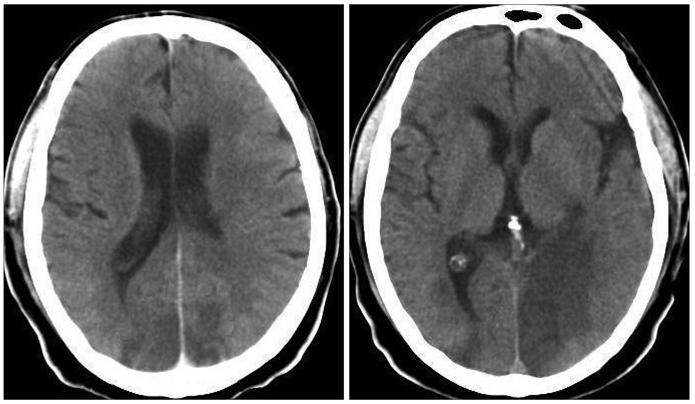J Clin Neurol.
2011 Jun;7(2):96-98. 10.3988/jcn.2011.7.2.96.
Anton's Syndrome and Eugenics
- Affiliations
-
- 1Department of Neurology, Rigshospitalet, Copenhagen University Hospital, Copenhagen, Denmark. daniel_kondziella@yahoo.com
- KMID: 2178973
- DOI: http://doi.org/10.3988/jcn.2011.7.2.96
Abstract
- Anton's syndrome is arguably the most striking form of anosognosia. Patients with this syndrome behave as if they can see despite their obvious blindness. Although best known for his description of asomatognosia and visual anosognosia, Gabriel Anton (1858-1933) made other significant contributions to the clinical neurosciences, including pioneering work in neurosurgery, neuropsychology, and child psychiatry. However, it has not been recognized in the English literature that Anton was also a dedicated advocate of eugenics and racial hygiene. This paper provides a case of Anton's syndrome and puts the works of Gabriel Anton into their historic context.
Keyword
MeSH Terms
Figure
Reference
-
1. Anton G. Über die Selbstwahrnehmung der Herderkrankungen des Gehirns durch den Kranken bei Rindenblindheit und Rindentaubheit. Arch Psychiatr Nervenkr. 1899. 32:86–127.
Article2. Stone SP, Halligan PW, Greenwood RJ. The incidence of neglect phenomena and related disorders in patients with an acute right or left hemisphere stroke. Age Ageing. 1993. 22:46–52.
Article3. Bartolomeo P. Visual neglect. Curr Opin Neurol. 2007. 20:381–386.
Article4. Santos CO, Caeiro L, Ferro JM, Albuquerque R, Figueira ML. Denial in the first days of acute stroke. J Neurol. 2006. 253:1016–1023.
Article5. Anton G, von Bramann FG. Balkenstich bei Hydrozephalien, Tumoren und bei Epilepsie. Munch Med Wochenschr. 1908. 55:1673–1677.6. Anton G, Schmieden V. Der Subokzipitalstich; eine neue druckentlastende Hirnoperationsmethode. Arch Psychiatr Nervenkr. 1917. 58:1–30.
Article7. Anton G. Über die Betheiligung der basalen Gehirnganglien bei Bewegungsstörungen und insbesondere bei der Chorea; mit Demonstrationen von Gehirnschnitten. Wien Klin Wochenschr. 1893. 6:859–861.8. Pfeifer B. Gabriel Anton. Deut Zentralbl Nervenheilk. 1933. 130:185–196.
Article9. Anton G. Über ärztlichen Rassedienst und Individualdienst, sowie über latente Veranlagungszeichen, Vortrag bei der Reichsgründungsfeier der Universität Halle a.S. am 19. Januar 1925. Arch Psychiatr Nervenkr. 1925. 73:563–580.
Article10. Anton G. Wohlfahrt und Wiedergenesung der deutschen Rasse. Psychiatr Neurol Wschr. 1915. 15/16:85–87.11. Anton G. Anton G, editor. Über Volksvermehrung und Höherzüchtung, Vortrag im Bund für Erhaltung und Mehrung der Volkskraft am 28.März 1918. Aus der ärztlichen Seelenkunde. Drei Vorträge für Ärzte, Lehrer und Erzieher. 1918. Berlin: Springer;34–48.12. Kondziella D. Thirty neurological eponyms associated with the Nazi era. Eur Neurol. 2009. 62:56–64.
Article
- Full Text Links
- Actions
-
Cited
- CITED
-
- Close
- Share
- Similar articles
-
- Life and Ideas of LEE Kap-Soo: Focusing on the Ideas and Activities Related to Eugenics
- Anton's Syndrome
- Eugenics Discourse and Racial Improvement in Republican China (1911-1949)
- The Characteristics of Korea's Eugenic Movement in the Colonial Period Represented in the Bulletin, Woosaeng
- Osseous Metaplasia in Hemangiomas of the Breast: Case Reports and Literature Review




